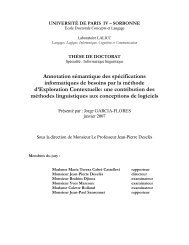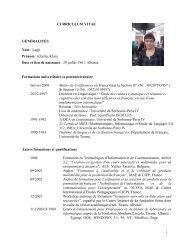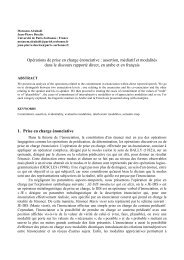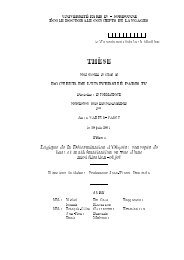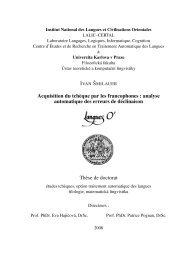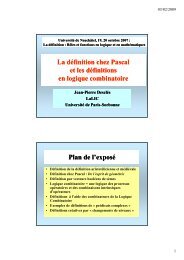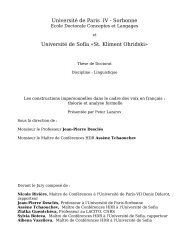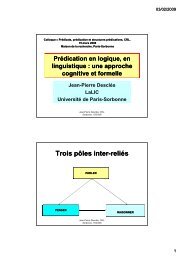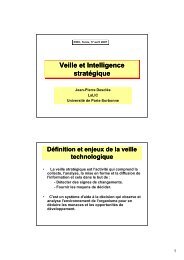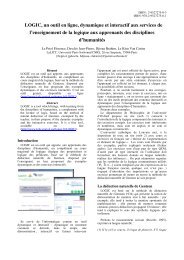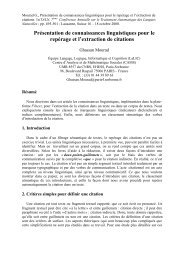EXCOM: An Automatic Annotation Engine for ... - ResearchGate
EXCOM: An Automatic Annotation Engine for ... - ResearchGate
EXCOM: An Automatic Annotation Engine for ... - ResearchGate
You also want an ePaper? Increase the reach of your titles
YUMPU automatically turns print PDFs into web optimized ePapers that Google loves.
<strong>EXCOM</strong>: an automatic annotation engine <strong>for</strong> semantic in<strong>for</strong>mation<br />
Djioua B. 1 , Garcia-Flores J. 1 , Blais A. 1 , Desclés J-P. 1 , Guibert G. 2 , Jackiewicz A. 1 , Le Priol F. 1 ,<br />
Nait-Baha L. 1 , Sauzay B. 2<br />
1<br />
LaLICC, UMR 8139 Université Paris-Sorbonne/CNRS<br />
28, rue Serpente, 75006 Paris, France<br />
{bdjioua,jgflores,ablais,jpdescle,ajackiewicz}@paris4.sorbonne.fr<br />
2 France Télécom, Division Recherche & Développement<br />
2 avenue Pierre Marzin, 22307 Lannion cedex, France<br />
{gaelle.guibert,benoit.sauzay}@francetelecom.com<br />
Abstract<br />
In this position paper we describe the actual state of the<br />
development of an integrated set of tools (called <strong>EXCOM</strong>)<br />
<strong>for</strong> automatic semantic annotation. <strong>An</strong>notation is generally<br />
used as an operation <strong>for</strong> marking textual segments to<br />
express some morphological and syntactic in<strong>for</strong>mation.<br />
Establishing the semantic web on a large scale implies the<br />
widespread annotation of web documents with ontologybased<br />
knowledge markup. For this purpose, tools have been<br />
developed that allow <strong>for</strong> semi-automatic annotation of web<br />
documents with ontology-based metadata. This paper<br />
describes an automatic engine <strong>for</strong> semantic annotations<br />
based on linguistic knowledge and making use of XML<br />
technologies. We are persuaded that using linguistic<br />
in<strong>for</strong>mation (especially the semantic organization of texts)<br />
can help retrieving in<strong>for</strong>mation faster and better in the web.<br />
The basis aim of this engine is to construct automatically<br />
semantic metadata <strong>for</strong> texts that would allow us to search<br />
and extract data from texts annotated in that.<br />
Introduction<br />
In the context of the semantic web, electronic documents<br />
are marked up with metadata, using manual annotation with<br />
web-based knowledge representation languages such as<br />
RDF and DAML+OIL (Handschuh and Staab, 2003) <strong>for</strong><br />
describing the content of a document. The aim of this work<br />
is to encourage the automatic annotation of electronic<br />
documents and to promote the development of annotationaware<br />
applications such as content-based in<strong>for</strong>mation<br />
presentation and retrieval.<br />
Natural language applications, such as in<strong>for</strong>mation<br />
extraction and machine translation, require a certain level<br />
of semantic analysis, which in practical terms means the<br />
annotation of each content segment with a semantic<br />
category (<strong>for</strong> a instance : definition, causality, citation or<br />
relation between named-entities).<br />
<strong>EXCOM</strong> is an XML based system <strong>for</strong> an automatic<br />
annotation of texts according to semantic categories. The<br />
system allows us to express linguistic knowledge associated<br />
to semantic categories in a declarative way.<br />
Our approach is based on the Contextual Exploration<br />
Method (Desclés et al, 1991, Desclés 1997), which states<br />
that semantic in<strong>for</strong>mation associated to textual segments<br />
can be identified by linguistic primary marks (called<br />
indicators) and a set of clues that would help to tackle their<br />
polysemy. <strong>EXCOM</strong> associate a set of linguistic marks<br />
(indicator and complements lists) and declarative rules <strong>for</strong><br />
each semantic annotation task. Conditions <strong>for</strong> executing a<br />
rule can be expressed in different ways, which switch on<br />
different levels of the engine. The result of a semantic<br />
annotation is a couple of documents, one <strong>for</strong> the structured<br />
text of the original text and other <strong>for</strong> the organized<br />
annotations <strong>for</strong> textual segments.<br />
Linguistic annotation model<br />
A major objective <strong>for</strong> <strong>EXCOM</strong> system is to explore the<br />
semantic of text in order to enhance in<strong>for</strong>mation extraction<br />
and retrieval through automatic annotation of semantic<br />
relations. Most of linguistic-oriented annotation systems<br />
are based on morphological analysis, part-of-speech<br />
tagging, chunking, and dependency structure analysis. For<br />
example, the framework GATE (Cunningham and all,<br />
2002) uses a set of reusable processing resources <strong>for</strong><br />
common NLP tasks which are similar of those described<br />
above.<br />
The methodology used by <strong>EXCOM</strong>, called Contextual<br />
Exploration, describes the discursive organisation of texts<br />
exclusively using linguistic knowledge present in the<br />
textual context. Linguistic knowledge is structured in <strong>for</strong>m<br />
of lists of linguistic marks and declarative rules. The<br />
constitution of this linguistic knowledge is independent of a<br />
particular domain. Linguistic rules <strong>for</strong> identifying and<br />
semantically annotating segments use different strategies.<br />
Some of these rules use lists of simple patterns coded as<br />
regular expressions, others need to identify structures like<br />
titles, section, paragraphs and sentences <strong>for</strong> extraction<br />
purposes. The most relevant rules <strong>for</strong> <strong>EXCOM</strong> are those<br />
called Contextual Exploration (CE) rules. A CE rule is a<br />
complex algorithm based on a prime textual mark (called<br />
indicator), and secondary contextual clues intended to<br />
285
confirm or invalidate the semantic value carried by the<br />
indicator.<br />
The core of <strong>EXCOM</strong> annotation model is divides on<br />
several interlinked parts:<br />
• Textual document<br />
• General metadata like (title, author, edition …)<br />
• Semantic annotations in relation with semantic<br />
categories<br />
In this context, an annotation is considered as a set of<br />
XML/Xlink markup (Blanken H and al 2003, www.w3.org)<br />
related to a relationship defined between a textual (segment<br />
(a sentence <strong>for</strong> instance) and an instance of a semantic<br />
category (see page 5 <strong>for</strong> annotation examples).<br />
• annotations (indicating the occurrence of a<br />
semantic category in a certain textual segment) ;<br />
<strong>for</strong> instance :<br />
o<br />
Connection relationships<br />
<br />
Physical proximity<br />
• “Mr Hollande meets<br />
prime minister Blair”.<br />
The process of <strong>EXCOM</strong> annotation consists of the<br />
following steps (depicted in Fig.1):<br />
Input: original text in HTML-XML-TXT <strong>for</strong>mat encoded<br />
on ISO-Latin1 or Unicode<br />
Step 1[Pre-processing]: documents are converted to plain<br />
text <strong>for</strong>mat<br />
Result: plain text <strong>for</strong>mat <strong>for</strong> document<br />
Step 2[Segmentation]: plain text document trans<strong>for</strong>med<br />
into structured document with structural annotations (title,<br />
section, paragraph and sentence)<br />
Result: physical structures <strong>for</strong> document<br />
Step 3[<strong>An</strong>notation]: Process of annotation <strong>for</strong> a specific<br />
task :<br />
Step 3.1[Regex rules]: Regular Expressions processing<br />
to identify first-level data (<strong>for</strong> instance, named-entities,<br />
locations, dates and temporal expressions).<br />
Step 3.2[Structure rules]: Rules to identify complex<br />
structures based on first-leval annotation<br />
Step 3.3[Contextual Exploration rules]: semantic rules<br />
processing with indicators and contextual clues <strong>for</strong><br />
identifying a semantic category. This step is a complex<br />
process explained below.<br />
Step 3.4[Negatives rules]: <strong>for</strong> identifying negations of<br />
semantic categories<br />
Step 3.5[Modality rules]: to identify the achieved and<br />
possible semantic relations.<br />
Result: Structured document and semantic annotation<br />
metadata.<br />
The process of semantic annotation<br />
The first step in constructing a linguistic categorization is<br />
to establish lists of semantic marks and contextual rules<br />
expressing a discursive notion (<strong>for</strong> instance, definition,<br />
citation and relationship between agents). The major<br />
subdivisions within a semantic categorization include:<br />
• structural segments of the document (title, section,<br />
paragraph, sentence)<br />
• linguistic marks (lexical, grammatical)<br />
• search space (right and left context, an specific<br />
position in the document)<br />
• indicator (verbs, prepositions, …)<br />
• linguistic clues<br />
Fig 1: <strong>EXCOM</strong> architecture<br />
The later one contains the result of the annotation process<br />
(annotated segments, annotation type, triggered rule,<br />
286
indicator, linguistic clues) and the first one contains the<br />
source document structured by section, title, paragraph and<br />
sentence.<br />
Post processing [Result analysis]: This last module <strong>for</strong><br />
<strong>EXCOM</strong> allows us to explore the result of the annotation<br />
process, that is, the structured and annotated document.<br />
<strong>EXCOM</strong> allows a user to explore an annotated document in<br />
three ways:<br />
• A graphical interface to navigate into the<br />
document, with colourful annotations,<br />
• A conceptual graph viewer, similar to dependency<br />
graphs.<br />
• <strong>An</strong> indexation engine that makes possible the<br />
storage of annotated documents using a<br />
Nutch/Lucene API, <strong>for</strong> semantic in<strong>for</strong>mation<br />
retrieval of web documents.<br />
Linguistic resources<br />
Linguistic resources are organized as typed semantic rules<br />
(contextual exploration rules, regular expression rules,<br />
etc.). Semantic rules are intended to capture the discursive<br />
organization of a text. Each rule is based on a set of<br />
markers lists, which can be used as indicators (to trigger the<br />
rule) or as clues (to confirm or refuse the annotation). List<br />
can be composed of lexical variations or regular<br />
expressions. These lists of linguistic terms are coded as<br />
Unicode plain files, while semantic rules are expressed in<br />
XML <strong>for</strong>mat.<br />
Fig 2: Markers lists<br />
third layer is charged of triggering Contextual Exploration<br />
rules. Let’s see in detail these levels:<br />
UNICODE: this layer allows the engine to per<strong>for</strong>m<br />
multilingual processing <strong>for</strong> semantic annotation. All<br />
documents processed in plat<strong>for</strong>m <strong>EXCOM</strong> are coded in<br />
UTF-8.<br />
REGEX: The first layer per<strong>for</strong>ms basic pattern annotation<br />
using a regular language. This level is used <strong>for</strong> namedentities<br />
identification, complex structures and some subsegments<br />
that will be used as indicators or clues. Each<br />
regular expression can use basic, extended or advanced<br />
regular expressions capabilities (look-ahead, look-behind,<br />
Unicode patterns, etc ..) and can also call list of markers<br />
qualified by algebraic operators. <strong>EXCOM</strong> uses the regular<br />
expression engine of the Perl programming language. <strong>An</strong><br />
example of annotation rule <strong>for</strong> named-entities.<br />
This above rule represents an annotation of two contiguous<br />
words which starts with capital letter as a proper name<br />
(Jacques Chirac, Tony Blair, etc…).<br />
STRUCTURE: this level makes possible to use preannotated<br />
segments as indicators or clues. This feature<br />
<strong>for</strong>ces the engine to reach every annotated segment in the<br />
document structure (done with XPath expressions). For<br />
instance, if a user needs to annotation a textual segment<br />
like “the British Prime Minister Tony Blair” as a named<br />
entity using <strong>EXCOM</strong>, he should proceed within several<br />
steps:<br />
(i) annotate nationalities (British) : markup <br />
(ii) annotate ‘Prime Minister’ as <br />
(iii) <strong>An</strong>notate with a regular expression <strong>for</strong> proper name<br />
(markup )<br />
(iv) Combining these structures (markups) with the artcle<br />
‘the’ to identify this complex named entity.<br />
A semantic annotation rule <strong>for</strong> this segment is<br />
The annotation engine<br />
The core of the annotation engine is organized on several<br />
layers interconnected (see Fig.1). The fist level layer<br />
(REGEX) encodes simple patterns as regular expressions.<br />
The second layer (STRUCTURE) allows the engine to<br />
trigger semantic rules from pre annotated segments. The<br />
287
CONTEXTUAL EXPORATION: This is the most<br />
important layer of the annotation engine. A CE triggers<br />
complex mechanisms that need the use of XSLT<br />
trans<strong>for</strong>mation language and a programming language (in<br />
this case, Perl). To continue with Prime Minister Blair, if a<br />
user wants to annotate a sentence like<br />
“The British Prime Minister Tony Blair was in visit last<br />
week at Paris be<strong>for</strong>e …”<br />
A semantic rule based on Contextual Exploration<br />
method would follow these steps:<br />
(i) Express the semantic of the meeting category by<br />
means of a relevant indicator, represented in this<br />
sentence by the verb ‘to be in visit’<br />
(ii) To confirm the indicator’s “connection semantic”,<br />
we need first to identify in the text the spatial<br />
expression ‘at Paris’ in this right context<br />
(iii) Indicator needs another expression like the named<br />
entity ‘The british Prime Minister Tony Blair’ to<br />
allow the engine to annotate the sentence.<br />
<strong>EXCOM</strong> uses an XSLT engine (with XPath parser) to<br />
identify nodes in the input XML document and process<br />
trans<strong>for</strong>mations by adding XML elements and attributes<br />
(see the below example).<br />
Semantic categorization: the connection task<br />
The semantic map presented here represents the various<br />
specifications of the semantic relation CONNECTION<br />
(who is with who).<br />
and a specific annotation. In the specific annotations,<br />
linguistic rules use ENAMEX (proper nouns and namedentities<br />
or locations, like Prime Minister, Downing Street,<br />
etc.) and TIMEX (temporal expressions). In generic<br />
annotation, rules are declared according to Contextual<br />
Exploration <strong>for</strong> an indicator (generally a verb) on a textual<br />
segment within clues expressing a connection relationship.<br />
Let’s explain the annotation process through a linguistic<br />
declarative rule <strong>for</strong> identifying a meeting relation between<br />
named entities.<br />
The annotation engine process as follow:<br />
(i) Identification of the indicator in the text (terms of the<br />
list “NomsDeRencontre” – a list of names like ‘a visit’) –<br />
this step generate an annotated and structured text with a<br />
markup “Visite<br />
”. This process also generates an XML<br />
document which represents the candidates segments <strong>for</strong> this<br />
rule.<br />
(ii) Generation of search spaces: parts of text where the<br />
engine will search the linguistic clues that will confirm or<br />
invalidate the indicator’s connection value (one being a list<br />
<strong>for</strong>m, the other two being the pre annotated segments<br />
named entities and spatial expression<br />
). These linguistic clues are<br />
identified sequentially (ordre_entre_indices=”suite” ).<br />
Only the right location is generated <strong>for</strong> this rule.<br />
Fig 2: Semantic map <strong>for</strong> connection semantic category<br />
The first level of the semantic map makes possible to<br />
release three types of meeting between agents: (i)<br />
collaboration, (ii) proximity and (iii) general meeting.<br />
Connection rules are triggered by occurrence of nouns<br />
connected to a meeting verb, and the semantic annotation is<br />
assigned if linguistic clues, like spatial prepositions, are<br />
found in the indicator’s context. In addition, the process<br />
annotation must distinguish between a generic annotation<br />
(iii) Identification of the first term from the list<br />
“IndiceDetRencontre” – a name determinant – ‘de/of’ in<br />
this text.<br />
288
(iv) Identification of the second and third clues declared in<br />
the rule as a pre annotation of named entities<br />
( and ). This<br />
operation is realized with an XML tree trans<strong>for</strong>mation<br />
using XPath/XSLT engine. A XSLT stylesheet is applied<br />
on the previous pre annotated XML document. This<br />
process produces two outputs: the structured document and<br />
its associated semantic metadata file.<br />
(v) <strong>An</strong>notation generation and relationship with the<br />
segment tile.<br />
<br />
<br />
Visite éclair de M. Hollande au Forum social<br />
de Florence<br />
<br />
...<br />
<br />
<br />
<br />
M. Hollande<br />
<br />
au Forum social<br />
<br />
<br />
de Florence<br />
<br />
<br />
<br />
This annotation express that a phrase (the title of the news<br />
paper article) is marked as a connection relationship<br />
between named-entities, whose one of the agents is<br />
identified as “M. Hollande”.<br />
<strong>EXCOM</strong> results are prepared with these two structures to<br />
be easily manipulated by final users towards graphic<br />
viewers. Programs can also use these two interconnected<br />
(XLinked structures) documents <strong>for</strong> in<strong>for</strong>mation extraction<br />
and in an indexing processing.<br />
Related Work<br />
<strong>EXCOM</strong> draws from a large pool of previous work on<br />
Contextual Exploration architectures and development<br />
environments <strong>for</strong> representing and processing scientist texts<br />
(Ben Hazez 2004, Crispino G. 2003). We have also drawn<br />
from work on representing texts with XML structures<br />
(DocBook and TEI grammars). The hierarchic layers of the<br />
annotation engine are drawn from the GATE framework<br />
architecture (Cunningham, 2002) – with an important<br />
distinction: using a new Contextual Exploration layer <strong>for</strong><br />
semantic annotations in discourse analysis.<br />
The annotation process results are viewed <strong>for</strong> this example<br />
within HTML/CSS file like :<br />
289
Conclusion and future work<br />
<strong>EXCOM</strong> is a comprehensive framework <strong>for</strong> creating<br />
automatic semantic annotations based both on Contextual<br />
Exploration method and XML technologies. This current<br />
version is being tested with different semantic<br />
categorisations like “relations between named entities” as<br />
shown in this paper, localization relations, text<br />
summarization and control sentences extraction. <strong>EXCOM</strong><br />
is the last implementation of “Contextual Exploration”<br />
system developed in the last ten years. This system benefits<br />
of the ContextO (Crispino, 2003) and Semantex (Ben<br />
Hazez, 2002) large experience. <strong>EXCOM</strong>’s future<br />
developments will include multilingual automatic<br />
annotation <strong>for</strong> semantic categorizations (mainly in Korean<br />
and Arabic languages). <strong>An</strong>other important feature under<br />
development at the current stage is the link between<br />
semantic annotation and web documents indexation. This<br />
feature will allow us to per<strong>for</strong>m real semantic oriented<br />
in<strong>for</strong>mation retrieval, which could be the base <strong>for</strong> a<br />
different type of web search engine. <strong>Automatic</strong> semantic<br />
annotation generated by <strong>EXCOM</strong> could be used <strong>for</strong> making<br />
a semantic inverted index able to find relevant documents<br />
<strong>for</strong> queries like “Who meets Tony Blair last year?”<br />
Desclés J-P., Jouis C., Oh H-G., Reppert D. 1991,<br />
Exploration contextuelle et sémantique : un système<br />
expert qui trouve les valeurs sémantiques des temps<br />
de l’indicatif dans un texte., in Knowledge modeling<br />
and expertise transfert, Eds D. Hérin-Aime, R. Dieng,<br />
J-P. Regourd, J-P. <strong>An</strong>goujard, 371-400. Calif : IOS<br />
Press,<br />
Handschuh S., Staab S., 2003, <strong>An</strong>notation <strong>for</strong> the Semantic<br />
Web, Volume 96 Frontiers in Artificial Intelligence<br />
and Applications, IOS Press<br />
Mourad G. 2001. <strong>An</strong>alyse in<strong>for</strong>matique es signes<br />
typographiques pour la segmentation de textes et<br />
l’extraction automatique des citations. Réalisation<br />
des Applications in<strong>for</strong>matiques : SegATex et CitaRE,<br />
Ph. D Thesis, Univ, Paris-Sorbonne<br />
XML, XPath, Xlink and XSLT recommendations:<br />
http://xmlfr.org/w3c/<br />
References<br />
Ben Hazez 2004, Modèle de filtrage et de structuration des<br />
textes, Conception et réalisation d’une plate-<strong>for</strong>me<br />
orientée objet, Ph. D Thesis, Université Paris-<br />
Sorbonne,<br />
Blanken H, Grabs T, Schek H-J, Schenkel R., Weikum<br />
G.,(Eds) 2003 Intelligent Search on XML Data,<br />
Applications, Languages, Models, Implementations,<br />
and Benchmarks, Springer Verlag,<br />
Crispino G. 2003, Une plate-<strong>for</strong>me in<strong>for</strong>matique de<br />
l'Exploration Contextuelle : modélisation, architecture<br />
et réalisation (ContextO). Application au filtrage<br />
sémantique de textes, Ph. D., Univ. Paris-Sorbonne<br />
H. Cunningham, D. Maynard, K. Bontcheva, V. Tablan.<br />
GATE: A Framework and Graphical Development<br />
Environment <strong>for</strong> Robust NLP Tools and Applications.<br />
Proceedings of the 40th <strong>An</strong>niversary Meeting of the<br />
Association <strong>for</strong> Computational Linguistics (ACL'02).<br />
Philadelphia, July 2002<br />
Desclés Jean-Pierre 1997, Système d’exploration<br />
contextuelle, in Co-texte et calcul du sens, 215-232.<br />
Calif : eds Guimier, Presses Univ. Caen<br />
290



